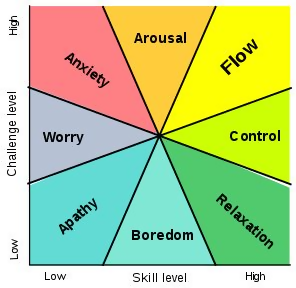Working in a "flow state" can enhance your performance, creativity and well-being.
Flow's combination of features makes it distinct from other mental state.
It involves calm, pleasurable and deeply focused concentration on a demanding task.
Flow has a problem-solving focus and it enhances innovation and creativity.
Positive psychologist Mihaly Csikszentmihalyi has studied creativity and "optimal experience" for decades.
He has produced several books on flow, as well as a viral TED Talk.
In an interview with Wired magazine, he described flow as:
Being completely involved in an activity for its own sake. The ego falls away. Time flies. Every action, movement, and thought follows inevitably from the previous one … Your whole being is involved, and you're using your skills to the utmost.
Flow occurs in a sweet spot where skill levels match a demanding challenge.
It requires a well-defined task with a clear goal.
This task must be very demanding but within your capabilities.
By working right to the edge of your skills, you can achieve more than you thought possible.
Flow is a joyous state of mind. It takes effort, but the work is energizing, rather than draining.
Fatigue fades away and mental agility increases. You lose track of time. And the quality and quantity of your output is greater than you would expect.
Regular work in flow will also improve your skills. Each flow experience extends your skills, like a good workout that makes you stronger.
Your brain in flow
Studies of electrical activity in the brains of people in flow are revealing.
For a start, they show suppressed activity in the prefrontal cortex (PFC).
This part of the brain manages complex cognitive behavior and decision-making.
The PFC deals with forethought and solving complex problems through logic and rationality.
But it is also associated with self-control and self-awareness. It is your inner editor and critic. This leads to second-guessing and self-criticism.
To achieve and maintain a flow state, you must set aside hesitancy and doubt.
Your PFC must take a backseat to other parts of your brain.
Studies also show that flow occurs mostly on the border of theta and alpha brainwaves.
Theta is a slow brainwave frequency (4Hz to 7.9Hz). It is related to meditation, dreaming, insight and the processing of new stimuli.
Alpha brainwaves (8Hz to 13.9Hz) are also relatively slow. Alpha is relaxed and calm - the brain's resting state. You are lucid and thinking, but not using rational, logic-based systems.
The next fastest category of brainwaves is beta (14Hz to 30Hz). At its low end, beta corresponds to concentration and learning; at its high end it relates to stress and fear.
Beta is the zone of rational, logical, step-by-step thinking.
But the flow zone is the realm of intuition and hunches. Rather than linear processing, it produces lateral thinking and creative leaps.
When you are using skills you have already mastered, you can set aside logic and linear thinking. When the PFC becomes less active, the brain's customary chatter fades away. Experience and intuition become your guides.
This lets other parts of the brain communicate more effectively with each other.
You can switch seamlessly from one area of the brain to another.
Accessing memories and musings from far-flung regions, you can rapidly make smart decisions.
Consider sport, where overthinking tends to create errors and hesitancy. You can't stop to consider how to strike at a fast-approaching ball – you must simply go for it. Similarly, a football player must respond instantly to fluid and unpredictable situations.
Many people can achieve more by separating creative and critical work. First, enter flow to create something spontaneous, fresh and new. Then switch the PFC back on to check and tweak their output.
A flow state's non-linear thinking enhances creativity. Sometimes it even leads to new insights and innovations.
These creative breakthroughs feature unusual brainwaves.
Flow has a holding pattern of high theta-low alpha brainwaves.
But there are also intermittent surges of ultra-high frequency gamma brainwaves.
At 32-100Hz, gamma is much faster than beta (12-32 Hz).
Gamma is linked with spurts of insight. It involves advanced information processing known as "binding". Different areas of the brain integrate different thoughts into a single new idea. Innovation occurs.
Experience of flow is its own reward
Flow suppresses the brain's and nervous system's threat-monitoring centres. Stress biochemicals dissipate. The inner critic falls silent. A feeling of relaxed well-being emerges. And a deep connection to the task develops.
Reduced activity in some parts of the brain creates more bandwidth for other parts. It also enables faster, more effective communication between different regions. Fatigue fades, intuition sharpens, and we can make faster, more informed decisions.
Confidence grows, endorphin and dopamine levels surge. A feeling of calm elation emerges. Many people report greater well-being and creativity for days after a flow experience.
Flow's enhanced productivity and creativity are fulfilling. But the feeling of transcendence is the greatest reward.
Regular flow experiences help develop a greater sense of purpose. It also enhances happiness, mental health and well-being in everyday life.
No wonder flow has become a hot topic for research. It is central to positive psychology and optimal human performance.
Flow in the workplace
We can experience flow in many activities – sports and the arts are notable examples.
But let's focus on its role in our working lives.
The McKinsey Quarterly reported on a major study of flow states in the workplace.
Executives said they were five times more productive in a flow state.
But they also said they and their staff were working in flow less than 10 percent of the time.
Because flow is so powerful, even a small increase in flow states could have a big effect.
Imagine increasing flow experiences from 10 percent to 14 percent of work hours.
That would almost double productivity.
We can't always achieve a state of flow. Some activities – administration, meetings and routine tasks – cannot generate flow.
But you can prime your environment and yourself for flow so that you experience it more often.
Achieving flow
First you must one specific task. This task must:
- be intrinsically rewarding
- have clear goals, expectations and rules
- be challenging but achievable
- provide immediate feedback through obvious indicators of success and failure, so you can adjust behavior as needed.
To achieve flow, you must then follow these steps:
- set a time limit/deadline
- remove distractions
- avoid interruptions
- enhance concentration – immerse yourself in the work
- work for long enough to build momentum and get into focus
- once you've worked long enough, take a break – then repeat.
You can't achieve flow unless you remove distractions and improve your ability to focus.
Find a quiet time. Use headphones if that helps and disable all call and message notifications.
Use a program like Focus – which boosts productivity while working on Mac computers. There are similar programs for Windows if that's your preferred operating system.
Focus can block browsers, games and distracting apps and websites. But it can still allow access to your to-do list, project management and productivity apps.
You can use Focus to block specific websites. Or use the allowed sites feature to access a few sites and apps while blocking the rest of the Internet.
Focus helps me transition quickly to a state of distraction-free concentration. And it helps keep me there.
Grow with the Flow
Once immersed in flow, you will experience:
- a loss of self-consciousness
- a feeling of becoming one with the job at hand
- merging of action and awareness
- calmness and elation
- time seeming to pass rapidly
- a surge in productivity.
Repeated immersion in flow will expand your attention span, confidence and staying power.
You will also be able to enter flow states more easily. This creates intrinsic motivation. The output is valuable - but the task and the flow state provide their own rewards.
Flow is a powerful and motivating pathway for growth and achievement.
Being able to consistently enter flow lets you do more work and better work. You can dramatically advance your career. And your working life will become much more enjoyable and satisfying.
References:
Flow: The Psychology of Optimal Experience (Mihaly Csikszentmihalyi)
Finding Flow: The Psychology of Engagement with Everyday Life (Mihaly Csikszentmihalyi)
The Rise of Superman: Decoding the Science of Ultimate Human Performance (Steven Kotler)
TED Talk: Mihaly Csikszentmihalyi: Flow, the secret to happiness (TED2004)


